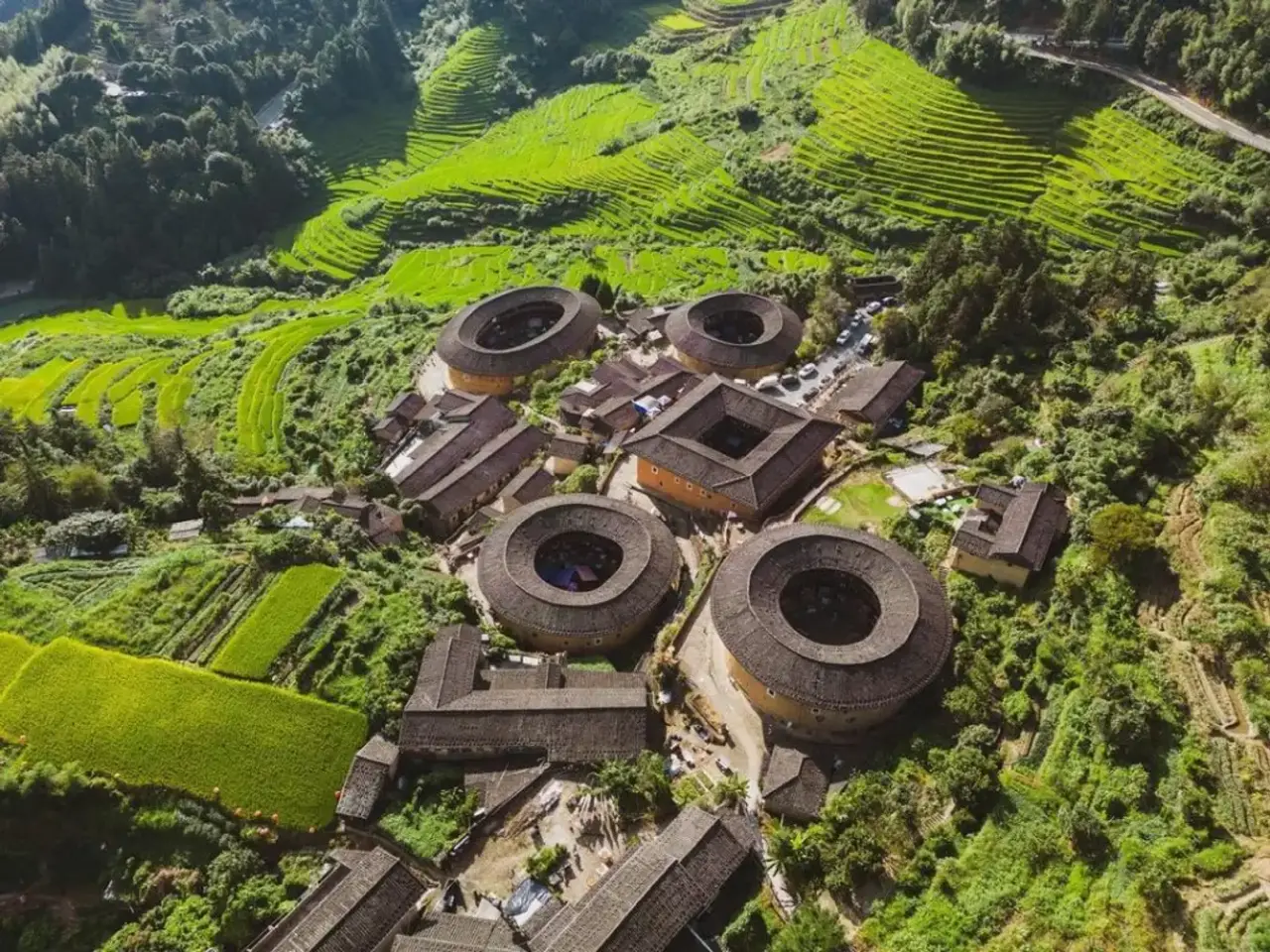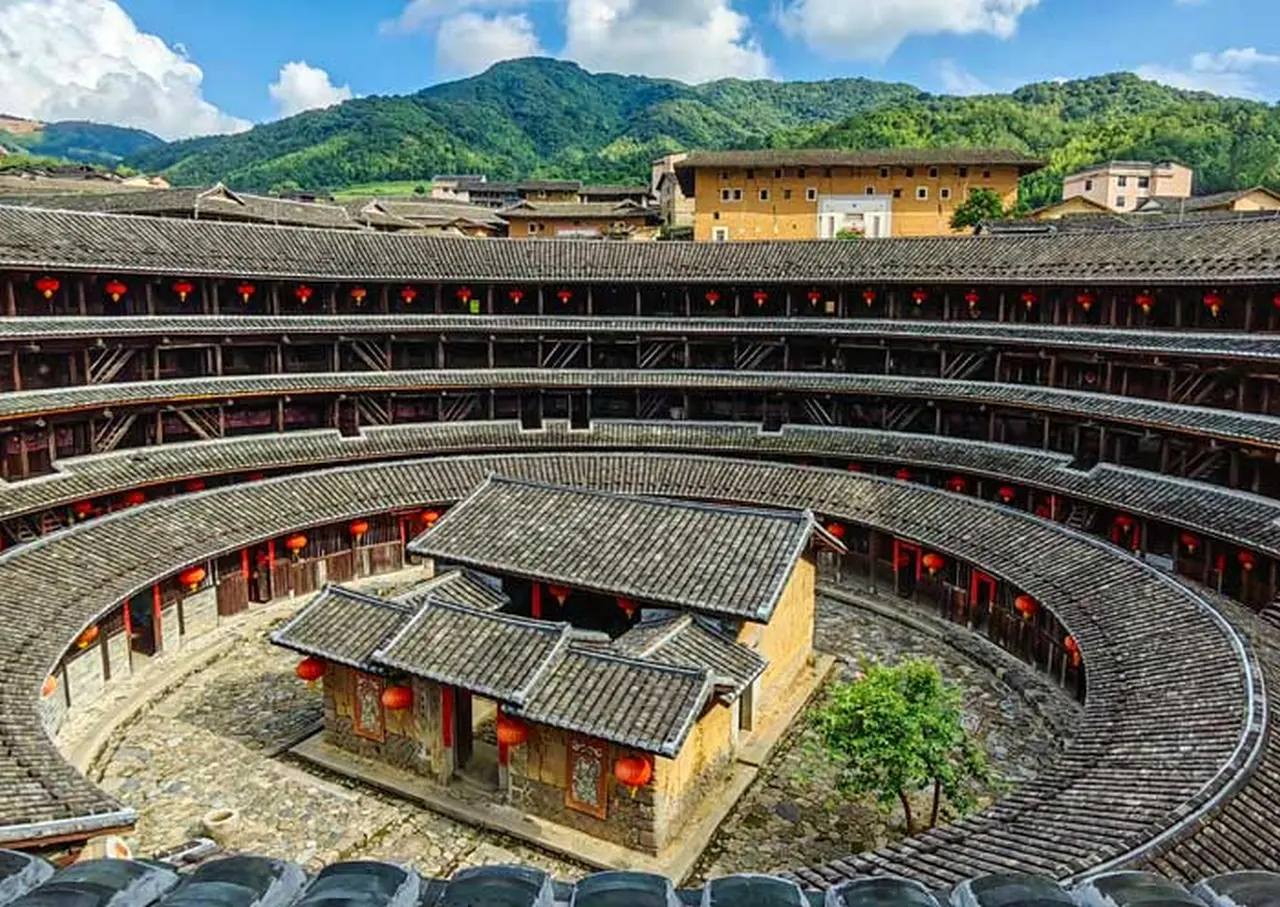Tulou refers to a unique collection of earth buildings primarily constructed by the Hakka people and other ethnic groups in the mountainous regions of southwestern Fujian Province, China. Most of these houses were built between the 12th and 20th centuries. The structures are well-known for their distinctive architectural style, often featuring large circular or rectangular buildings designed for communal living. These houses were historically used as fortified homes, providing safety and shelter for large extended families.
According to National Geographic, each Tulou typically takes on a circular or rectangular shape, featuring massive walls that rise three to five stories high and are topped with tiled roofs. These structures can accommodate up to 800 people. Inside the thick walls are halls, storage areas, wells, and living spaces, creating a fortress-like micro-city.

>> Longyou caves: A mysterious wonder defying time and imagination
The walls are constructed by mixing rammed earth with stones, bamboo, wood, or other locally available materials, resulting in walls up to 1.8 meters (6 feet) thick. Branches, wood, and bamboo are often embedded deep within the walls to provide reinforcement. As a result, these buildings are well-lit, ventilated, wind-resistant, earthquake-proof, warm in winter, and cool in summer.
Fujian Tulou typically has only one main gate, which is secured by four thick wooden doors, ranging from 100 to 130 millimeters (4 to 5 inches) in thickness, and further reinforced with steel plates on the exterior. The topmost floor of the Tulou features gun holes designed specifically for defensive purposes.
Yeo Kang Shua, Associate Professor of Architectural History, Theory, and Criticism at the Singapore University of Technology and Design, explained: “The doors of Tulou are typically constructed with granite frames, while the window frames are made of wood. Since there is only one entrance, the building becomes more fortified and harder to breach. Moreover, the windows are usually positioned only on the upper floors, making it extremely difficult for intruders to enter through them.”

However, unlike the sturdy and fortified exterior, life inside the Tulou is incredibly simple and grounded in everyday routines.
At the center of a Tulou is usually an open courtyard, often featuring a water well, known as the main courtyard. This space serves as the area for ancestor worship and communal activities such as weddings and funerals. Families living within the same Tulou typically experience minimal distinctions in terms of social status or wealth.
>> The “Kingdom of Women”: A matriarchal society where men take the back seat
All the apartments within a Tulou are constructed identically, and shared resources such as water wells and fruit trees are generally considered communal property rather than belonging to any specific family. This sense of equality in relationships, combined with the defensive advantages of the architecture, made it easier for Tulous to fend off bandit raids that were prevalent in southern China.
Kang Ger-Wen, Assistant Professor at the Department of Chinese Studies, National University of Singapore, explains: “Most residential areas feature ancestral altars and schools for children. The Hakka people consider family relationships and education as the two most important aspects of their lives.”

Each Tulou operates like a self-contained village. The buildings are typically divided into sections for families belonging to the same clan or lineage. This arrangement fosters a sense of communal living, where resources like the ancestral altar and shared spaces are often managed collectively, emphasizing the close-knit and cooperative nature of Hakka society. This communal structure provides both social and defensive benefits, with everyone living under the same roof and looking out for one another.
>> The most mysterious lake in China said to be home to a water monster
Modern Tulou buildings are equipped with electricity and clean water, providing a more contemporary lifestyle while maintaining their traditional structure. However, the main sources of food and sustenance still largely rely on self-sufficiency, with residents either growing their own crops or purchasing goods from nearby villages. This blend of modern conveniences and agricultural self-reliance reflects the enduring cultural values of the Hakka people, who continue to live in these remarkable earthen structures.

The hallways connecting the individual rooms on each floor of a Tulou are deliberately designed to encourage interaction among the neighbors living within the same structure. This architectural feature fosters a strong sense of community, as residents often engage with one another in shared spaces, promoting social cohesion and collective support within these close-knit living environments.

There are a total of approximately 46 distinctive Tulou houses located in villages such as Chuxi, Tianluokeng, Hekeng, Gaobei, Dadi, and Hongkeng. This group of Tulou houses was recognized as a UNESCO World Heritage Site in 2008. On its official website, UNESCO praised the Tulou as “an outstanding and exemplary example of human settlement forms.” These ancient earthen structures represent an exceptional combination of practical design, cultural heritage, and social organization.
>> 10 most famous mountains in China – Where scenic beauty feels otherworldly

The term “Fujian Tulou” is the official designation given by UNESCO for this unique architectural structure in China. There are currently over 20,000 Tulou buildings still in existence today, though only about 3,000 of them are officially recognized as Fujian Tulou.

In recent years, the population living in these Tulou houses has steadily declined as younger generations seek more opportunities in larger cities. However, thanks to local policies promoting tourism, these remarkable structures continue to thrive with vibrant business activities and cultural festivals, maintaining their historical and cultural significance. This blend of ancient tradition and modern tourism helps ensure the Tulou remains an iconic and active part of China’s heritage.
>> Conquering Hua Shan – The world’s most dangerous trail, Where challenge meets wonder
Tips:
Fujian has a mild climate throughout the year, but from March to August is typically the rainy and typhoon season. The dry season, from September to December, is considered the best time to visit.
Most tourists usually spend half a day visiting the Fujian Tulou. However, for a more authentic experience, you can book homestays here, enjoy local cuisine, and immerse yourself in the simple, everyday life of the Hakka people.






